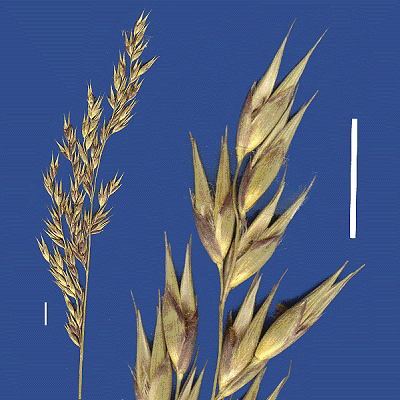 |
 |
|
 |
 |
|

Eriachne nervosa Ewart & Cookson
|
Common name
Plains Wanderrie Grass
Derivation
From Greek erion (wool) and achne (chaff or scale), possibly referring
to the florets being hairy or else to the indumentum of the whole plant.
nervosa- from the Latin nervus (nerve) and -osa (abundance). With conspicuous nerves in the glumes or lemmas.
Published in
Fl. North. Terr. 44 (1917).
Habit
Perennial, tufted. Cataphylls present. Rhizomes elongated, hairy. Culms erect,
robust, 60–105 cm tall, 3–5-noded. Mid-culm internodes smooth. Mid-culm
nodes glabrous. Lateral branches simple. Ligule a fringe of hairs. Leaf-blades
8–30 cm long, 2–4 mm wide, glaucous. Leaf-blade surface glabrous or
hairy.
Inflorescence
Inflorescence compound, a panicle. Panicle open or contracted, linear or oblong,
7.5–22 cm long, 1.5–3.5(–5) cm wide. Primary panicle branches
appressed or ascending, 1–5 cm long. Panicle axis smooth. Panicle branches
smooth, bearded in axils, with prominent pulvini.
Spikelets
Spikelets solitary. Pedicels 1–10 mm long. Fertile spikelets 2-flowered,
comprising 2 fertile florets, without rhachilla extension, ovate, laterally
compressed, compressed slightly, 11.5–14 mm long, breaking up at maturity.
Spikelets disarticulating below each fertile floret.
Glumes
Glumes opposite, persistent, similar, thinner than fertile lemma. Lower glume
ovate, 5.8–9 mm long, equalling upper glume, membranous, 13–17-nerved.
Lower glume surface smooth, glabrous. Lower glume apex acute or acuminate. Upper
glume ovate, 6–8.5 mm long, membranous, 13-nerved. Upper glume surface
smooth, glabrous. Upper glume apex acute or acuminate.
Florets
Fertile lemma lanceolate, laterally compressed, 8–14 mm long, chartaceous
or cartilaginous or indurate, 7-nerved. Lemma surface with 2 longitudinal grooves,
pilose. Lemma margins involute. Lemma apex acuminate or cuspidate, muticous
or mucronate or 1-awned. Median (principal) awn 2–4 mm long overall. Palea
embraced by lemma or gaping, 11 mm long, 100% of length of lemma, chartaceous.
Palea keels scabrous. Palea surface pilose or hirsute, hairy on back, hairy
below. Grain with adherent pericarp, 3–3.5 mm long.
Continental Distribution:
Australasia.
Australian Distribution:
Western Australia, Northern Territory, Queensland.
Western Australia: Fitzgerald. Northern Territory: Darwin & Gulf, Victoria River, Barkly Tableland, Central Australia North. Queensland: Burke, Gregory South.
Classification. (GPWG
2001):
Incertae Sedis: Eriachneae
Notes
Endemic. N.T. N of 21šS, NW Qld, and recorded from W.A. only by Petheram
611. A characteristic species of the grey to black, cracking clay, grassland
plains of the Barkly Tableland and similar areas, where plants form large stands
in or near swamps, depressions, watercourses, and major drainage channels. Flowers
and fruits in the N.T. and Qld May–Aug. (late autumn to winter), and also
Oct. (mid spring); in W.A. in Feb. (late summer).

Inflorescence and detail of inflorescence (scanned specimen)
© Queensland Herbarium
by Will Smith